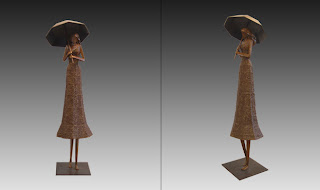In the late 1800's, a radical group of Paris-based artists broke all the rules of traditional painting. Far from the realistic and more academic paintings of the past, impressionists moved away from classical painting and began to paint in a way that captured movement and a different perspective. In short, their aim was not to create an exact replica, but to provide the viewer with an impression of a scene captured in a specific moment in time.
Perhaps the most well known impressionist, Claude Monet, was a factor in how the term impressionism came into being, after a critic saw his piece,
Impression, soleil levant.
 |
| Monet - Impression, soleil levant | | |
Painting in an impressionistic manner is done differently than more traditional painting. Short brush strokes that apply the paint directly onto the canvas are used, and the more thickly applied paint on the canvas is referred to as impasto. The idea behind impressionism is that the paintings are supposed to be spontaneous, and often painted on location.
SmithKlein Gallery has several impressionistic painters in the gallery at this time. Here are two artists that we feature:
 |
| Gerard Mortier - La Fenetre |
Gerard Mortier’s work takes the viewer on an intimate tour of the country he knows and loves best, the Opal Coast of France, a seaside stretch of land on the English Channel from Calais to Etaples. Considered to be the “ambassador of the Opal Coast”, Mortier brings to life the region’s beaches, farms, fishing boats, and winding village streets. Ambivalent weather and ever-changing light are captured through his masterful use of broad strokes and vibrant colors. Traversing the region with his easel, Gerard paints as the light of the moment inspires him. The soft mauves and blues of the skies and the luminescent immaculate white facades, blue shutters, and brilliant orange rooftops of the region’s houses are typical of Gerard’s work. Using a thick application of paint with a palette knife and brush, impasto style, and large vertical and horizontal planes of brilliant color, he makes palpable the power of the wind and sea that characterize this part of France. When not traveling, Gerard also finds subjects to paint in the tranquil garden of his rustic country home in the northern part of his country.
 |
| Lyudmila Agrich - Toward the Sun |
Lyudmila Agrich was born in Russia. After changing her place of residency several times, her family finally settled down in the beautiful city of Odessa in Ukraine by the Black Sea. As a child she got all attention and love from her parents. They were always encouraging in all of her creative expressions. As a result she spent several years in musical school and the school of fine arts for children. She was lucky because she was able to taste the nectar of creativity so early, and intuitively she knew in the beginning what could bring her happiness and contentment. But when she had to make a choice she went to Architectural school and received bachelor degree in Architecture and Fine Arts.
After practicing architecture for a few years in Ukraine and then in the USA (since 1992) she became miserable in technical field of beams and concrete. She started to hear very strange calling for painting. She quit architecture in 2001 and became a professional artist. Her choice is not her career; it is her life, fulfilled and happy. She replaced her painting brush with palette knife in order to create bolder, brighter, and powerful images of nature, flowers, and people. Her style is expressionistic impressionism. She is not looking for a new style or new techniques to shock or amaze people. The main focus is to capture intimate moments in ordinary life. No matter what she is painting, a landscape, or a little cafe in an old European town, she wants her paintings to speak in the language of human feelings. She tries to avoid creating pictures that are just pretty. Instead she wants to communicate with people by evoking similar emotions and feelings in them.
















